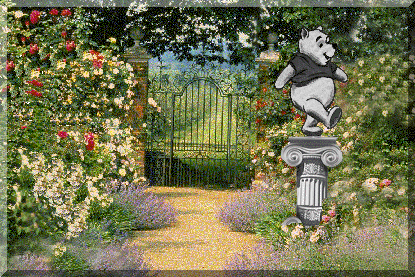

~THE MAN WHO GAVE WINNIE-THE-POOH LIFE:
Alan Alexander Milne (A.A. Milne) was born in London on January 18, 1882, the third and youngest son of a schoolmaster.
At age eleven, he won a scholarship to the Westminster School. He went on to attend Cambridge University. After graduating in 1903,
Milne moved back to London with enough savings to live for one year, determined to become a writer. By 1906, he had been offered the position of Assistant Editor at PUNCH, a classic
British humor magazine. He remained there for the next eight years.
In 1913, Milne married Dorothy de Selincourt (known as Daphne) and moved to a house in
London's Chelsea section. When World War I broke out, he enlisted in the Royal Warwickshire
Regiment, eventually serving in France. During his training period, he wrote his first play,
"Wurzel-Flummery," which was produced in London in 1917.
By 1919, having completed one book and several plays, Milne finally achieved financial
independence. His play, "Mr. Pim Passes By," previously staged in London, was produced by the
Theatre Guild in New York City. It was as great a success there as it had been on the London
stage. Milne was now well-established as a witty and fashionable London playwright. In 1920,
Christopher Robin Milne was born--an event which would alter the lives of children everywhere. In 1923, during a rainy holiday in Wales, Milne began work on a collection of verses
for children. The result was WHEN WE WERE VERY YOUNG, published in 1924.
Demand for Milne's whimsical work was overwhelming, and in 1926, he duplicated his earlier
success with the publication of WINNIE-THE-POOH. The sequel, THE HOUSE AT POOH CORNER, followed
in 1927. NOW WE ARE SIX, another charming collection of verse, followed one year later. It was
through these four books, all illustrated by the wonderfully talented Ernest H. Shepard, that
Milne acquired a vast audience outside of the theater. In the years since their initial publication,
interest in these books has grown and grown.
Milne continued to charm the literary world until his death in 1956.
Ernest H. Shepard was born in 1879 in London. His father was an architect and his mother, who
died when he was ten years old, was the daughter of a notable watercolorist. It was she who first
encouraged young Ernest to paint and draw. Art became Ernest's passion, and after attending
Heatherly's Art School and the Royal Academy Schools, Shepard supported himself by drawing
for the illustrated papers and by illustrating books.
In 1903, Shepard married Florence Chaplin. Florence was a mural painter and fellow student at
the Academy. The Shepards had two children: Graham, who was killed in World War II, and
Mary, who later illustrated Mary L. Traver's Mary Poppins books.
When World War I broke out, Shepard served in France, Belgium, and Italy, attaining the rank of
Major. On his return to England, he continued with his art. He became a regular contributor to
PUNCH, where he met A.A. Milne, a man who was to be
instrumental to his career. Shepard was elected to the editorial board of PUNCH, and shortly
thereafter, he agreed to do the illustrations for Milne's first book of verse, WHEN WE WERE VERY
YOUNG.
The illustrations that Shepard created for all four of the Pooh books received worldwide acclaim.
For the next thirty years, he continued to illustrate books for both adults and children. In 1973,
for the first time, he added color to his drawings for Winnie-the-Pooh. Shepard ultimately
donated several hundred drawings to the Victoria and Albert Museum in London.
Ernest H. Shepard continued to pursue his love of drawing until his death in 1976.
 |
When Christopher Robin was a year old, he was given a stuffed bear from
Harrods, and later a tiger, pig, and donkey. The idea of bringing these toys to
life in a children's book is credited to Daphne Milne.
In 1924, Dutton Children's Books published the first of A.A.
Milne and Ernest H. Shepard's books for children.
In several poems, a rather tubby bear was featured. That bear became one of the most beloved
literary creations of all time when Winnie-the-Pooh was published on October 14, 1926.
Winnie-the-Pooh has been in print ever since and sold more than 20 million copies in all his many
editions.
In 1928, the second of the original Pooh books, THE HOUSE AT POOH CORNER was published. That
was followed by NOW WE ARE SIX.
Winnie-the-Pooh has appeared not only in books but on a wide range of items, from pottery to
postage stamps, bookends to bed linens. He has starred in videos, on radio, and on the stage. His
birthday is celebrated by school children all over the world.
Although A.A. Milne was famous in his lifetime as a contributor to the British humor magazine
PUNCH and as a prolific playwright, his lasting fame, much to his chagrin, has been based on
Pooh.
Pooh's career will continue as long as there are readers to take delight in the tales of a rather
stout and very lovable bear.
 |
*Special thanks to Dutton's Children's books for many of the historical facts presented herein.